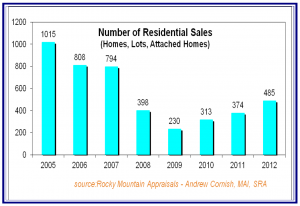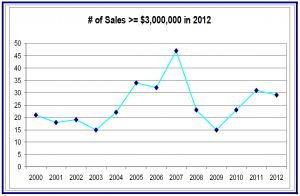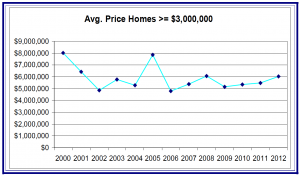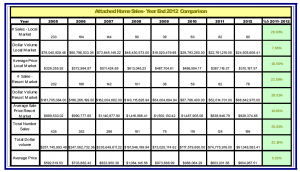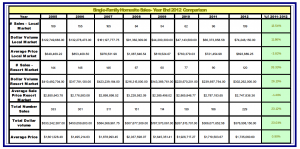Prices Hold Level Through 2012 – Sales Volume Up By Nearly 30%
Observing data for yearend 2012, an increase in the number of transactions of over 29% was noted in comparison to 2011 data from this time period. This gain came in combination with an average price measure that remained essentially level. The result of these indications was an increase in dollar volume of sales of over 27%. Closer observation of the data provides that this generalization is reasonably accurate, but worth clarification by viewing the market when segmented into its component parts of the more expensive “resort” market versus the less expensive “local” market. When viewing the market in this manner, it is noted that the average price of transactions in the local market decreased by approximately 5%, with the resort segment also showing a slight decrease in average price. The fact that both market segments showed a slight decrease in average sale price, but the composite of these two segments provided the indication of a level value trend, reveals the impact of the high end market segment on this year’s data. As an example, while the number of sales occurring at prices greater than $3,000,000 was slightly down (31 sales in 2011 compared to 29 sales in 2012), the average price of these high-end sales was up over 10% from $5,482,187 to $6,045,793. What can be intuited from this data is that the strength of the luxury home market has contributed to having the overall average price trend remain level. That said, this should not be interpreted to imply that the high end real market is propping up a floundering local real estate market. Rather, an increase in sales volume in some of the more moderately-price developments in the local market has diluted the average price measures downward, but does not indicated a devaluation trend of the individual properties that comprise the aggregate data.
Combined Sales Data – All Property Types
(click on tables/charts to see enlarged view)
Single-Family Residences > $3,000,000 – Number of Sales
Single-Family Residences > $3,000,000 – Average Sales Price
Summary of Market Statistics By Property Type
Vacant Homesite Market Segment
The number of land sales showed the greatest increase in sales volume (number of sales) when comparing 2011 to 2012 data, perhaps indicating some bullishness coming back into the real estate market. This increase in activity was evident in both the local and resort market segments. It was noted that the average price in this segment was off by just under six percent. However, this fluctuation is seen as being due to the changing composition of the inventory of lots sold, rather than an indication of individual property price erosion trends. In support of this, it was noted that five lots in the Karns Hillside Subdivision sold in 2012 (as compared to no sales of vacant land in this development in 2011) and three lots sold in the Walden Pond Subdivision. Increases in sales volume of such lower-price lots is a positive market indicator but, being lesser-priced lots, would serve to lower aggregate averages. Noteworthy instances of increased sales volume in the resort segment of vacant land were also observed in developments such as Granite Ridge (5 lot sales in 2012 as compared to 1 in 2011) and Shooting Star (7 lot sales in 2012 as compared to 2 in 2012.
Attached Home (Condominium / Townhouse) Market Segment
Since the coining of the term “mortgage crisis” the attached home (condominium and townhome) market has been suffering. The lack of financing options for such homes, combined with the contraction of the speculative market for income producing resort condominiums caused some of the greatest value loss in the Teton County Market to be seen in the attached home market segment. While financing challenges have not disappeared for this type of property, the pricing of attached homes appears to have reached a level that has attracted purchase interest. The number of sales in both segments increased substantially, with the composite of both market segments posting a nearly 26% increase in the number of sales. Overall, the average pricing of condominiums held level when compared to 2011. This report was the result of the average price of the resort segment units increasing and the average price of the local market segment decreasing by about 15%. However, these changes appear to be primarily the result of flux in the type of units being sold and not an indication of appreciation or further value erosion. As an example, it was noted that nine units sold in 2012 in the Meadowbrook Village Development (one of Jackson’s more affordable developments), whereas only one such unit sold in 2011. The increase in sales volume of units from this less-expensive development would logically be expected to decrease average sales prices, while not implying a value erosion trend for the local market. This is not to say that all evidence of market softness for condominium units has evaporated. Viewing sales in the Aspens Racquet Club in 2012, one bank short sale unit in the Alders building was noted to sell at an over 28% discount compared to an adjacent unit that had sold the year previous.
Single-Family Residence Market Segment
The single-family residence market had a solid year, with the total number of sales and the dollar volume of sales both increasing by approximately 23%. Overall, the average transaction price of single-family residences remained generally flat from 2011 to 2012 when viewing the aggregated data. This indication is generally corroborated when viewing individual property sales. While the lack of adequate number of sales and re-sales of the same single-family residence preclude a definitive proof of a price rebound, analysts at Rocky Mountain Appraisals have noted instances of valuing the same property twice during the time period of 2011 through 2012, and interpreting the available market data to indicate a higher value in 2012 than was estimated in 2011.
Real Estate – Commercial
Trend analysis of theTetonCountycommercial real estate market is hampered due to the size of the market area. That is to say that the relatively small number of commercial real estate transactions occurring create a situation where one sale can easily skew averages and median price data. Therefore, the health of theTetonCountycommercial real estate market is most accurately described without heavy dependence on statistical measures. That said, it was noted that the number of commercial sales in the Teton County Market area numbered 18 sales, which is identical to that of 2011. When examining recent trends in rent and vacancy levels, it had been evident that value erosion occurred throughout all segments of the commercial real estate market through 2010. At the close of 2011, it appears that the commercial market had largely stabilized. Perhaps the hardest hit of commercial market segments has been development parcels that were slated to be redeveloped with mixed use buildings, often featuring ground floor retail and high-end residential condominiums on their upper floors. With the economic feasibility (and in some cases legal permissibility) of such developments becoming questionable in 2009, property values for such property had been hypothesize to have lost as much as 70% of their value from previous peak levels. Such hypotheses were supported with more tangible market data in 2012, with several commercial land sales resetting market expectations for this type of property.
Retail Market – The retail market for 2012 saw three sales. While this was a decrease from the previous year’s tally of six or seven sales (depending on interpretation), the observed sales traded at overall capitalization rates of between 5% and 6%, rates noted to be similar to that of 2012. Rents for this market segment can range from $10.00 per square foot for large retail spaces suitable for big box tenants, to approaching $50.00 per square foot for spaces in proximity to theJackson Town Square – with smaller “kiosk” spaces renting for even more. Leases had typically been written in a triple net format, with the tight retail market having allowed for well-located properties to command premium rental rates. However, vacancies rose throughout 2008-09 with reports of concessions being offered in both rental rates and interior build out and landlord absorbing some building expenses (rather than passing them all through to tenants) being noted. Significantly discounted rents were noted to be negotiated during 2011. However, during 2012 rents were noted to stabilize at rates typically within 15% – 20% of peak values.
Office Market – The office market for 2012 saw five sales of office space, identical to the number of the previous year. Capitalization rates accepted by investors and owner occupants typically existed between 5% and 6%, with some sales transacting at rates of return less than 5%. Prior to 2007, the office market inTetonCounty had been one of the stronger commercial sectors, with very little available space to rent. The shortage of office space that existed in 2007 spilled over into early 2008, before the contracting economy was acknowledged in this market segment. The contracting economy’s affect on this segment had been compounded by the completion of several large projects that were begun during the more robust economy. A lack of demand combined with increased inventory forced rental rates for office property downward at this time. Properties previously thought to have rental rates above $30.00 per square foot were being leased for less than $20.00 per foot. This trend began to stabilize during the summer of 2011, with some larger office projects that had been completed near the peak of the market achieving stabilized occupancy; 2012 saw a slow but perceptible strengthening of the office market, with rents typically approaching levels within 15% of peak values.
Light Industrial – The light industrial segment of the Teton County Commercial Real Estate Market saw six sales, up two sales from the previous year. All of these sales were properties suitable for owner-users, whose assumptions of full occupancy and personal use typically equated to overall rates less than 5%.
Hotel / Motel – National hostelry analysts had forecast an increase in lodging demand for 2012 with increases called for in the metrics of occupancy, average daily rate, and revenue per room. This trend materialized in 2012, with the Rocky Mountain Lodging Report reporting thatJackson area hostelry properties experienced a 2.21% growth in average daily rate and a 5.3% increase in occupancy, for an overall growth in revenue per room of 7.5% this past year. Sales volume of hostelry properties was up in 2012 as well with four sales being noted in 2012. However, one of these sales was an inventory of 18 condominium hotel units (and two commercial units) at the Hotel Terra Development that were purchased out of foreclosure. This sale was reported to be acquired with the goal of the eventual resale of the units on an individual basis and was not considered a typical hostelry purchase. Two large hostelry transactions occurred in 2012, with the Snow King Hotel inJackson and the Snake River Lodge and Spa inTetonVillage having been purchased. Both of these sales had aspects that cloud the ability to extract an overall rate of return on the sale. However, it was reported that both of these sales targeted returns indicative of capitalization rates in the higher single digits.
Vacant Land (Commercial) – During the approximate five years leading up to the current period, vacant commercial land had enjoyed strong price growth. This growth in price existed with most land type categories, but was most noticeable in the intensely-zoned UC (Urban Commercial) zoning district. This was largely due to the speculation that, through the use of the PMUD (planned mixed-use-development) provision of the Jackson Land Development Regulations, large amounts of building area could be profitably developed. Further fueling the price growth in land conducive to PMUD projects was the inclusion of residential product in PMUD developments. The influence being that many developers envisioned strong price growth for residential product and were willing to pay premium prices for land as a result. As a result, land sales inJackson’s more development-intensive zoning districts progressed from price points in the $130 per square foot range in late 2005 to over $265 per square foot in 2008. In 2012 two sales of properties that are similar to the properties that at the above-specified peak values sold for between $109 and $123 per square foot. These sales can be represented as being as much as 58% less than historic high water marks. Furthermore, one property in the less intensive AC zoning district was noted to have sold in 2012 for nearly 70% less than adjacent land which had previously sold for in 2008 for more than $240 per square foot. A large parcel of land that had been excavated for the construction of a PMUD property was also observed to have sold at a very steep discount. However, concerns over post acquisition costs for ground stabilization and maintenance of the property that has locally come to be referred to as “theJackson Hole” figured heavily into this discount. Land value losses were also noted inTetonVillage, where the development parcels that were purchased in 2007 for the development of high end condominium hotel projects (reported Ritz Carlton and Little Nell Hotels) were sold out of foreclosure for discounts as great as 75% off of their previous acquisition prices.
Commercial Rental Supply and Demand – As was discussed in the previous analysis of the retail and office sectors, the rental market inJackson appears to have stabilized. And, while no dramatic rebounds are be noted, the rental market appears to be slowly improving. As of January 2013, the Teton County MLS was reporting a combined tally of slightly over 27,000 square feet of office and retail space. While not as tight as pre-2008 occupancy, this is in considerable contrast to 2009, when the addition of several new projects to the existing office retail space created an excess supply that was approximate to be as high as comprising 50,000 – 60,000 of unused space.
Summary
Subsequent to the onset of a national recession in mid-2007, the Teton County Market Area experienced a period of limbo, where market participants were waiting to see if the Teton County Real Estate Market would prove “recession proof” or at least “recession resistant,” as it had been during previous economic slowdowns. Subsequent to the near collapse of the financial markets in late 2008, the seriousness of the then existing economic conditions were acknowledged to exist in full force inTetonCounty, with significant value loss occurring from this period through the middle of 2011. At approximately the end of the second quarter of 2011, generally speaking, the Teton County Real Estate Market began to show signs of stabilization. This trend has continued through 2012. In the residential real estate market, this stabilization has been most evident in increasing sales volume with pricing discounts not being necessary to attain this improved volume. The Teton County Commercial Real Estate Market also showed positive signs in 2012 with a slowly improving rental market and stable sales volume. However, perhaps the most important commercial market change came in the form of market sellers acquiescing that the market had “reset” and selling commercial properties at price points that may hopefully entice development.
Regards,
Andrew Cornish, MAI, SRA
President, Rocky Mountain Appraisals




